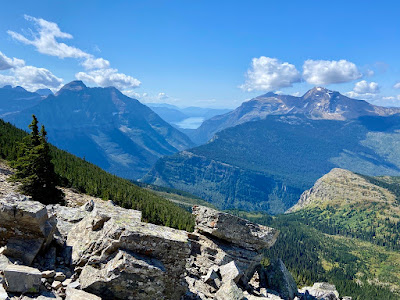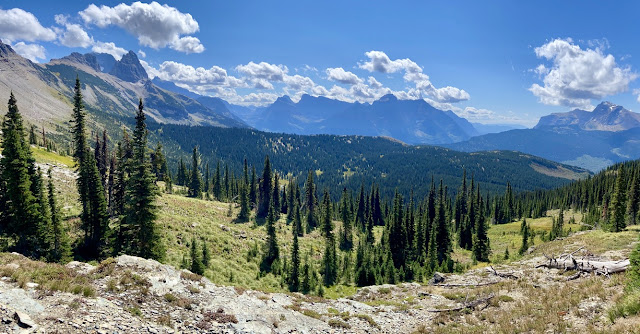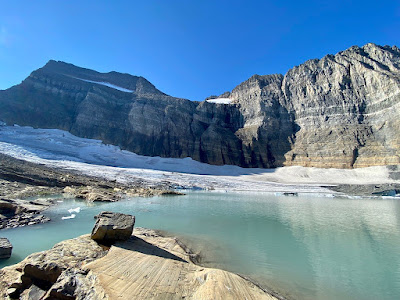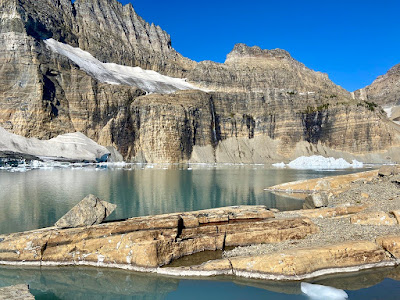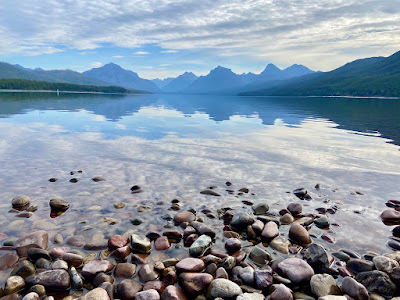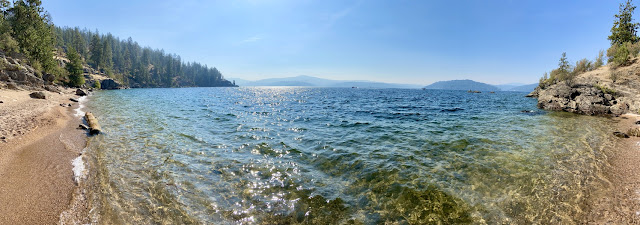For thousands of years, the park's glaciers naturally cycled through periods of advance and retreat. The current glaciers were at their largest at the end of the Little Ice Age (around 1850), then started to retreat with the onset of a warming trend. While the decrease of glaciers is due to both natural and human-caused climate change, the retreat seen in recent decades can be increasingly attributed to anthropogenic causes.
Most of the park’s glaciers are tucked into shadowy niches high along the Continental Divide, cloaked by semi-permanent snowfields. Late August and early September, when most of the winter's snow has melted away, is the best time to see the glaciers. Ironically, Glacier is not the best park to see an active glacier. They can be viewed more easily in Alaska's national parks, Mt. Rainier National Park, Olympic National Park, North Cascades National Park, and Grand Teton National Park.
Most of the park’s glaciers are tucked into shadowy niches high along the Continental Divide, cloaked by semi-permanent snowfields. Late August and early September, when most of the winter's snow has melted away, is the best time to see the glaciers. Ironically, Glacier is not the best park to see an active glacier. They can be viewed more easily in Alaska's national parks, Mt. Rainier National Park, Olympic National Park, North Cascades National Park, and Grand Teton National Park.
Day 1: Flathead Lake
Tom and I left on Wednesday morning with a 10-hour drive ahead of us. After the Columbia River Gorge, the drive through eastern Washington was not noteworthy until Spokane.
Crossing into Montana, we lost an hour in transition to the Mountain Time Zone. I enjoyed the drive along the western shore of Flathead Lake--the largest natural freshwater lake west of the Mississippi in the lower 48 states. The high elevation setting reminded me of Lake Tahoe.

That evening, we camped in West Glacier at Mountain Meadow RV Park (campgrounds inside the park fill up many months in advance). Given Oregon's strict fire ban this year, we were excited to build a small campfire.
Day 2: Logan Pass to the Loop via Highline Trail
Tom and I woke up early on Thursday to beat the crowds to the trailhead. We packed up our tent in the pre-dawn cold, and drove an hour to Logan Pass. The weather was ideal for our trip, with daytime temperatures in the high 60s and lots of sun; nights and mornings were chilly, however, dipping down into the mid 30s. Layers are crucial.
Trailhead: Logan Pass
Mileage: 11.8 mile thru hike + 1.6 miles to Grinnell Glacier Overlook
Elevation: 2,000' gain, 7,500' max
Time: 5.5 hours
Description: a moderate trek along a narrow, exposed path carved out of the cliffs that tower over the Going-to-the-Sun Road; features unbeatable views along the Garden Wall with a chance to see glaciers, alpine wildflowers, and wildlife
Highlights:
-Very crowded; trailhead parking lot full by 7am
-Detour to overlook is steep but worth it
-If unable to coordinate shuttle or hitch back to Logan Pass (thanks Cate and Carole!), turn back after the overlook or Granite Chalet
-Detour to overlook is steep but worth it
-If unable to coordinate shuttle or hitch back to Logan Pass (thanks Cate and Carole!), turn back after the overlook or Granite Chalet
After the hike, we drove the remainder of the Going-to-the-Sun Road to stay at a tiny cabin in East Glacier Park Village. Only one thing took precedence before a shower and bed: margaritas.
Day 3: Grinnell Glacier
Another early alarm on Friday before driving an hour to the Many Glacier area of the park. East Glacier feels more remote than busier West Glacier. It has a long history of wildfires, and is the place for sunrise.
Trailhead: Grinnell Glacier
Mileage: 11 miles
Elevation: 2,100' gain, 6,515' max
Time: 4.5 hours
Description: a moderate trek to a famous glacier through stunning alpine scenery and emerald green lakes
Highlights:
-Very crowded; trailhead parking lot full by 7am
-Watch for wildlife: deer, big horn sheep, mountain goats, moose, black/grizzly bears
-The glacier is becoming increasingly underwhelming as it continues to melt
-Watch for wildlife: deer, big horn sheep, mountain goats, moose, black/grizzly bears
-The glacier is becoming increasingly underwhelming as it continues to melt
Just 40 minutes away in East Glacier, Tom and I camped at Johnson’s of St. Mary’s. We spent a lazy afternoon soaking in the sun and cool mountain air amongst the aspen trees; the sweetness of doing nothing.


Day 4: Lake McDonald
On Saturday, Tom and I had planned to round out our trip with an easy 5-mile hike to Hidden Lake. Upon arriving at Logan Pass, however, we were informed that the trail had been closed due to bear activity. Check trail status beforehand!
As a result, we continued driving towards West Glacier, and decided to rent kayaks on scenic Lake McDonald. The water was clear and glassy; an excellent way to end our time in the park.
After our morning paddle, we finished our stash of PB&Js and drove 2 hours west to stay in small town Hot Springs. The cozy B&B was a nice treat for our final night on the road.
Day 5: Coeur d'Alene
It was a luxury to sleep in on Sunday, with only 8 hours left to drive home. We stopped for brunch in Coeur d’Alene, Idaho. Despite the wildfire smoke, we used the break to stretch our legs on the trails and beaches of Tubbs Hill peninsula. I look forward to exploring more of the lake and bike/pedestrian trails next time.I could not be more pleased with the result of our road trip to Glacier. As an added bonus, it was a very inexpensive vacation. The park is among my favorite national parks to date, second only to North Cascades and maybe Grand Teton. On a future visit, I would explore less popular areas of the park. The highlight of my summer!







